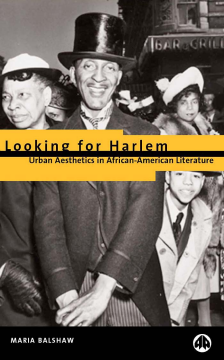
Additional Information
Book Details
Abstract
Taking the incredible flowering of African-American literature in the 1920s as its starting point, Looking for Harlem offers a cogent and persuasive new reading of a diverse range of twentieth-century black American writing.
From the streets, subways, hotels and cabarets of New York's Harlem and Chicago's Southside, Maria Balshaw moves beyond the canon to encompass often neglected writing by Rudolph Fisher, Wallace Thurman and Claude McKay, as well as the more familiar work of Richard Wright, Ralph Ellison, Nella Larsen and Toni Morrison. In a provocative revision of African-American literary history, Balshaw examines the creation of an ‘urban aesthetic’ and explores the links between the engagement with the city and fictional reconstructions of racial identity and race writing. Focusing on the material culture of the city, the visual sense of the urban environment, the class dynamics of urban culture and the crucial importance of consumerism, this study presents a critically astute, challenging and very welcome new approach to a much-studied area of contemporary American fiction.
Table of Contents
| Section Title | Page | Action | Price |
|---|---|---|---|
| Contents | vii | ||
| Acknowledgements | ix | ||
| Introduction | 1 | ||
| The Criteria of Negro Art | 6 | ||
| The Race Capital | 10 | ||
| 1. New Negroes, New Spaces | 14 | ||
| Racialised Urbanity | 17 | ||
| From the Harlem Special Issue to The New Negro | 20 | ||
| Fire!! Magazine | 23 | ||
| 2, Space, Race and Identity | 30 | ||
| The H of Harlem | 32 | ||
| Harlem Hierarchies: Racial Performance, Social Space | 36 | ||
| 3. Passing and the Spectacle of Harlem | 44 | ||
| New Women, New Negroes | 46 | ||
| Spectacle, Race and Gender | 52 | ||
| Danse Sauvage | 61 | ||
| Passing Encounters, City Scenes | 63 | ||
| A Vital, Glowing Thing | 69 | ||
| 4. Women in the City of Refuge | 72 | ||
| The Closing Door | 75 | ||
| The Silent Story | 79 | ||
| On Being Young - A Woman - and Colored | 83 | ||
| Frye Street: All the World is There | 86 | ||
| Nothing New | 88 | ||
| Black Notes/ City Notes | 94 | ||
| 5. Consumer Desire and Domestic Urbanism | 97 | ||
| Reading the Urban Domestic | 101 | ||
| Reading the Signs Inside | 109 | ||
| Small Victories | 117 | ||
| 6. Elegies to Harlem | 123 | ||
| Looking For ... or At? | 129 | ||
| Bitch or Dumpling Girl | 134 | ||
| Conclusion | 141 | ||
| Notes | 143 | ||
| Introduction | 143 | ||
| Chapter One: New Negroes, New Spaces | 145 | ||
| Chapter Two: Space, Race and Identity | 150 | ||
| Chapter Three: Passing and the Spectacle of Harlem | 152 | ||
| Chapter Four: Women in the City of Refuge | 157 | ||
| Chapter Five: Consumer Desire and Domestic Urbanism | 161 | ||
| Chapter Six: Elegies to Harlem | 163 | ||
| Index | 166 | ||
| Africa, and African American | 40 |
